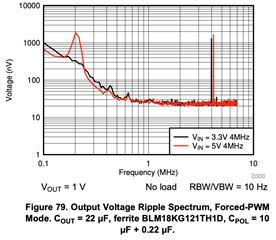Hi there,
We are reading the data sheet and trying to get good performance out of this part. Below is the data sheet I refer.
https://www.ti.com/lit/ds/symlink/lp87524j-q1.pdf?ts=1676360173340
In Fig. 79. I pasted below. The 4MHz tone is <2uV. This is so much below the 4mV output voltage ripple, shown in spec table in Page 7 of the same data sheet. Could you please let me know how to achieve this performance?


